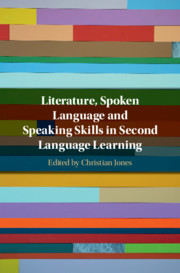Book contents
- Literature, Spoken Language and Speaking Skills in Second Language Learning
- Literature, Spoken Language and Speaking Skills in Second Language Learning
- Copyright page
- Contents
- Figures and Tables
- Contributors
- Foreword
- Acknowledgements
- 1 Introduction
- Part I Literature and Spoken Language
- Part II Literature and Speaking Skills
- Index
- References
1 - Introduction
Published online by Cambridge University Press: 18 October 2019
- Literature, Spoken Language and Speaking Skills in Second Language Learning
- Literature, Spoken Language and Speaking Skills in Second Language Learning
- Copyright page
- Contents
- Figures and Tables
- Contributors
- Foreword
- Acknowledgements
- 1 Introduction
- Part I Literature and Spoken Language
- Part II Literature and Speaking Skills
- Index
- References
Summary
Part I of the book explores literature as a vehicle for developing awareness of spoken language. Byrne and Jones examine dialogues from a literature corpus in comparison with a spoken corpus to understand the extent to which literary dialogues offer a plausible model of conversation. Tomlinson then examines how literature can be used as part of a text-driven approach in order to develop an awareness of pragmatic uses of spoken language. Jones and Cleary examine the effects on input enhancement when using televised literature to develop students’ awareness of features of spoken language. Iida focuses on students’ composed haiku poems and the features of spoken language they contain. Zhao and Liu report on a classroom-based action research study which employed screenplays. Part II explores the use of literature as a means of developing speaking skills. McIlroy examines the effects of discussing poetry at different levels of familiarity with learners Shelton-Strong analyses group discussion from Literature Circles, whereby learners discuss texts they have read. Finally, Fogal and Pinner measure changes in lexical complexity on the speech of learners as they discussed literature.
- Type
- Chapter
- Information
- Publisher: Cambridge University PressPrint publication year: 2019
References
References
- 1
- Cited by

